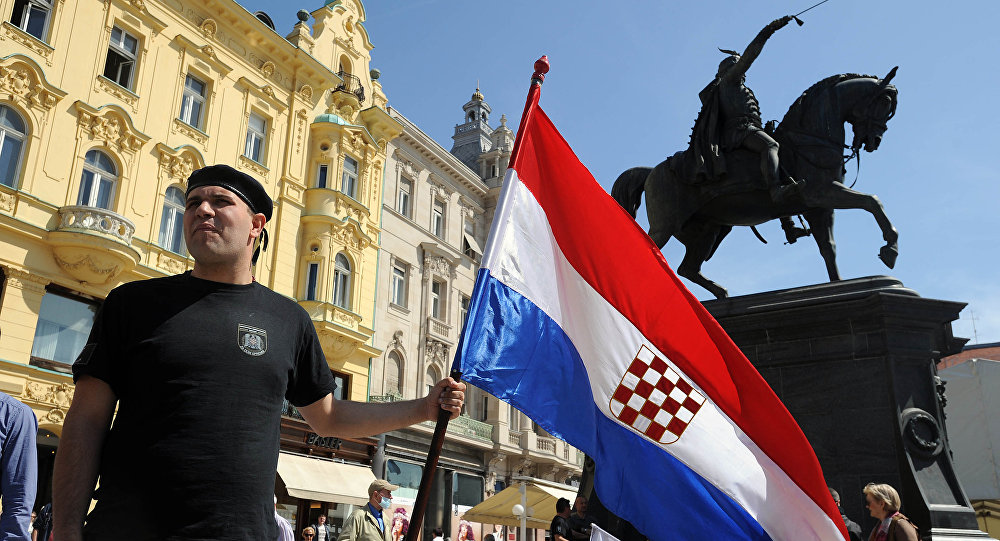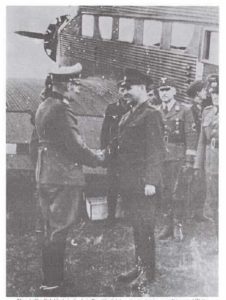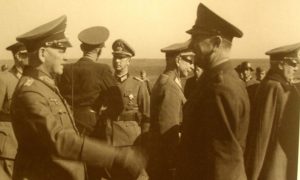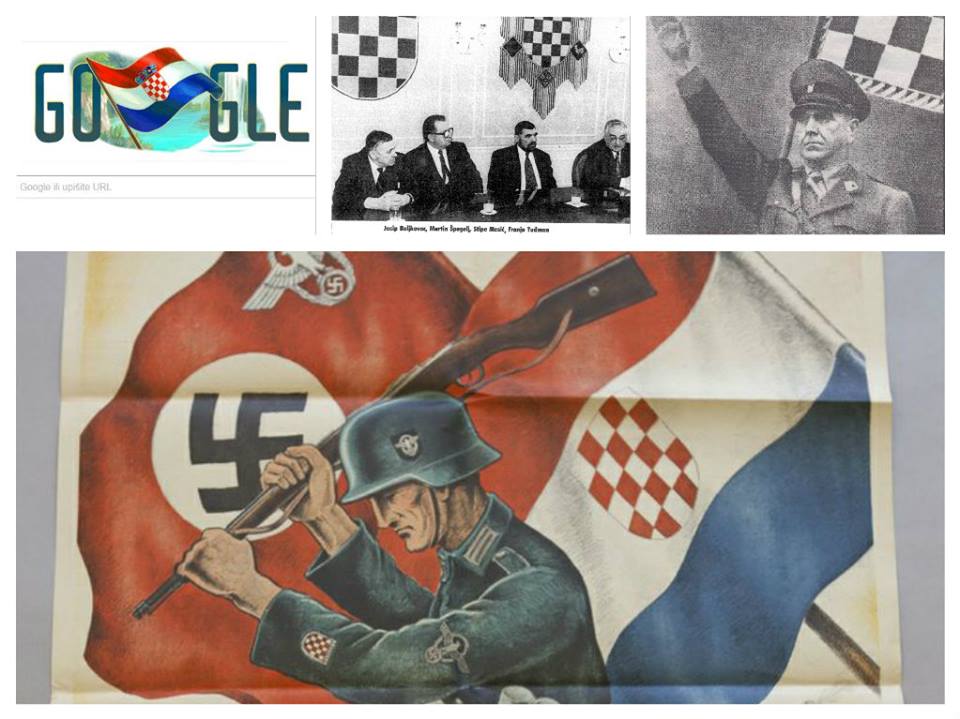
Views: 2640
The September 24, 1942 visit by NDH leader Ante Pavelic to Golubinskaya outside of Stalingrad was the culmination of decades of an anti-Communist, anti-Soviet ideology. Ante Pavelic was an anti-Communist ideologue. He saw Nazi Germany, a nation based on the principle of race, as maintaining racial purity. The Third Reich “had shaken off the infections of Bolshevik racial ‘promiscuity’.” The Soviet Union threatened his core values. Germany was perceived as the antithesis of the USSR. Pavelic saw that Germany “has a showdown with the poisonous Bolshevik snake, which had started to spread its wings over all of Europe”. Germany and the Soviet Union were on a collision course. A conflict was inevitable. Germany would emerge victorious, would “crush the head” of Communism by destroying the Soviet Union. He opposed Soviet Communism because it negated the family, religion, private property, and the nation. Ideologically, Communism was the opposite of Fascism, which alone could engage and destroy it. This was the ideological basis of the NDH role in Operation Barbarossa and the Battle of Stalingrad.
 Ante Pavelic made known his ideological views in a book first published in 1938 in Italy while he was in exile in Siena, Italy. Pavelic wrote the book in Italian under the pseudonym AS, Ante Serdar. The book was originally published as Errori e Orrori, comunismo e bolscevismo in Russia e nel mondo. The English translation is Errors and Horrors or The Horrors of Delusion: Communism and Bolshevism in Russia and the World.
Ante Pavelic made known his ideological views in a book first published in 1938 in Italy while he was in exile in Siena, Italy. Pavelic wrote the book in Italian under the pseudonym AS, Ante Serdar. The book was originally published as Errori e Orrori, comunismo e bolscevismo in Russia e nel mondo. The English translation is Errors and Horrors or The Horrors of Delusion: Communism and Bolshevism in Russia and the World.
At the time, Ante Pavelic lived under confinement or house arrest in Italy. This was the result of a diplomatic treaty between Yugoslavia and Italy, the Italian-Yugoslav Agreement of March 25, 1937, a five-year non-aggression and neutrality pact whereby Yugoslavia recognized Ethiopia as part of Italy while Italy made trade concessions and granted language and school rights for the Yugoslav minority. Italian government authorities immediately seized the book at the time. But in 1941, after the break with the Axis, a second edition of the Italian version was republished by Instituto per gli studi di politica internazionale, Institute for International Policy Studies in Varese-Milan, Italy.
In 1941, a Croatian-language edition was published in the NDH by Tiskara knjižare St. Kugli in Zagreb as Strahote zabluda: komunizam i boljševizam u Rusiji i u svijetu, consisting of 276 pages in a softcover binding, red letters on a blue background. It was described as “prvo domovinsko izdanje”, “the first domestic printing”. It was the third edition.
It was republished in 1974 in Madrid, Spain, and in 2000 in Zagreb. A new edition of the book was published in 2011 in Zagreb by Studio Moderna.
In the book, he discussed the history of Communism in Russia and its threat to Western Europe in 1937.
The book opened with an Introductory Word or Preface by Dr. Ante Pavelic, dated 1937. In his introduction, he argued that Communism threatened the institutions and values of the West.
He examined the development of the Bolshevik Movement in Russia under Vladimir Lenin in “The First Part: Communist Theory and Bolshevik Practice in Russia.”
He equated Communism with Yugoslavism, with the Royalist Yugoslav regime, although that regime was also anti-Communist and anti-Soviet. He attacked Communism because it negated the family, “the worth and importance of blood ties”. The family was at the core of human life. Communism sought to destroy it. Religion was central to maintaining a familial order. This is why it was attacked by Communism. The family, the nation, and religion: These were central institutions that Communism destroyed. Communism espoused internationalism, atheism, and materialism. This was due to the fact that “the great majority of the intellectuals” who advocated Communism were of the Jewish race. The Jews had assumed leadership of the working class movement and the peasant or agrarian movements but they had historically been merchants and speculators, not workers, farmers, or soldiers. So he saw this as a usurpation. Racially, he saw the Croats as an Aryan race like the Germans. Race or ethnicity was the basis of the nation. Communism sought to destroy national identity by destroying the homogeneity of the nation.
Bolshevism uses force and violence to achieve its aims, by committing “the most terrible crimes”. Without the Bolshevik seizure of power in Russia, there would be no Communist state in the world. There never had been. Now the goal is to create a world state led by Moscow. “A Bolshevik upheaval means blood, horrors, and destruction.” Communism as an effective practical phenomenon never existed, does not exist, and never will exist except in books and lectures.
Does the proletariat, the working class, have power in the Soviet Union? The Politburo rules, that is, a Party organ. Every policy, political, economic, or military measure has its origin within this party body. The proletariat, the Russian workers, are not represented in this dictatorship.
Collectivism is not innate to man. Is it healthy and natural? Can it provide happiness and satisfaction? Factory life is dehumanizing. The farmer is also alienated from the land. “Barbaric” Bolshevism results in the “destruction of human civilization and education.”
Man has a natural or physical life and a spiritual life that science cannot fully explain. “Bolshevism has denied any existence of the mental part of man. “The Bolsheviks declared man a mere animal, who lives on earth as a clean slate, without a soul, without ideals, and without any purpose.” The individual wallows in “a morass of materialism”. Religion was banned. A rigid atheism or “bezbožnjačtvo” was instituted. Churches and altars were toppled, prayer was forbidden. What has replaced religion? Nothing. A reliance on the machine and the physical world.
What is “natural”, therefore, is “a community of blood”. The family, the natural human cell of society, stands in the way of artificially creating an unnatural Communist society, which denies the value and importance of blood ties, because the bloodline is denied by internationalism and non-nationalism or “beznarodnosti”. Morality is corrupted by free love and a denial of the family. These constitute the Communist community or družtvenog. Communism and the family are incompatible. There can be no family life when the government controls all aspects of the life of an individual.
Communist education is limited to practical subjects only. Art only serves the government. Literary censorship is rampant.
The Soviet Union is a police state. The police rages uncontrolled and unlimited without any restrictions. The system is led by the “bloody red autocrat Stalin”. Russia is part of “eastern primitivism” and religious “mysticism” which moves in a fog of superstition and ignorance.
Vladimir Lenin’s successors have experimented for twenty years to establish socialism in Russia but have failed. There was a power struggle. Stalin consolidated power, forcing Leon Trotsky out of the leadership.
The Second Part of the book is entitled “Soviet Russians and Preparing for World Revolution”.
Communism is not confined to Russia, but is a worldwide phenomenon. “World revolution” is the goal, even if presently postponed. The government of the Soviet Union organizes subversion in other countries, in all countries in the world. The Comintern has the task to prepare for world revolution. It acts directly under the authority and under the government of the Moscow Bolsheviks.
The Communists seek to destroy nationalism and the nation. The nation is destroyed by eradicating the family. Religion is the next target for destruction. Any “national consciousness” must be destroyed.
Fascism, as it exists in Italy and Germany, is a reflection of the will of the people. It cannot be created from above, by the government, but emerges from the people. Fascism is based on a movement of ideas and of the people while Bolshevism is based on barbarism and destruction. These two movements must confront each other while the democracies watch on the sidelines.
Bolshevism is based completely on the denial of self-rule. Self-rule was developed since Roman times. Italian fascism emerged to confront Bolshevism. “Italy is the land of sun and light, but she could not give to overcast Bolshevik darkness and the Moscow ice.”
Likewise in Germany, where the German people could not stand up to Bolshevism. Germany produced a new leader who quickly restored the great power and value of the Geman people, and raised it even higher and made it stronger, yet more powerful and even readier than it has ever been, and against the shackles imposed by the Versailles peace “dictates”, and against the Bolshevik invasion. He revived the old German army, which ensured the German people their homeland, and National Socialist and racial Germany shook off the infection of Bolshevik racial “promiscuity”, “permikstuacie”, and tackled the toxic Bolshevik dragon, which started to spread wings over the whole of Europe. It will crush the head of Bolshevism. “Bolshevism is evil and wants to reign everywhere. Fascism stands to fight with him to the death.” It must, therefore, be challenged everywhere, in every corner of the globe. This conflict carries within it the struggle of the nation for life against death. He quoted Benito Mussolini as advocating this view.
He concluded by stating that the Spanish Civil War is a battleground of these two worlds, fascism and Communism.
Democracies could not protect the West from Communism. Democracies were weak and ineffective. Therefore, fascism developed as a bulwark against the East. Ante Pavelic wrote in the chapter “Fascism and Communism”: “Fascism is not ‘the antithesis of Democracy’, as it is usually wrongly claimed, but her successor as ‘the antithesis of communism’.” Western democracies could not confront or combat Bolshevism. Britain and France cannot stop Communism. Democracies had failed. Fascism emerged as the system that could defeat Bolshevism. Fascists are following in the traditions of the Roman Empire. Italy and Germany had to combat the Bolshevik menace. This could not be accomplished through a democratic government.
As a Roman Catholic, atheistic Communism or “Bolshevism” would be anathema for Ante Pavelic. As a narrow ethnic nationalist, universalist and international Communism would not work. “Bolshevism” as a Russian or Soviet ideology would not work for a Westernized, Germanized, and Romanized Croat.
 Ante Pavelic was an ardent supporter of Operation Barbarossa. Ideologically, he was a committed anti-Communist. Moreover, Adolf Hitler’s New Order in Europe ensured Croatian independence. These were the major reasons for his unconditional and unwavering allegiance. Two days after the launching of Operation Barbarossa on June 23, 1941, Pavelic volunteered to give Hitler thousands of Croatian and Bosnian Muslim troops for the operation. In a speech he stated that Croatians “cannot remain peaceful observers in this great and fateful hour, but burn with a desire to take part in the battle to destroy the greatest enemy of humanity and Croatdom.” Approximately 8,000 Croat and Bosnian Muslim troops were part of the invasion of the Soviet Union. An incentive for joining was that they would receive double pay and that they would be rapidly promoted in the ranks.
Ante Pavelic was an ardent supporter of Operation Barbarossa. Ideologically, he was a committed anti-Communist. Moreover, Adolf Hitler’s New Order in Europe ensured Croatian independence. These were the major reasons for his unconditional and unwavering allegiance. Two days after the launching of Operation Barbarossa on June 23, 1941, Pavelic volunteered to give Hitler thousands of Croatian and Bosnian Muslim troops for the operation. In a speech he stated that Croatians “cannot remain peaceful observers in this great and fateful hour, but burn with a desire to take part in the battle to destroy the greatest enemy of humanity and Croatdom.” Approximately 8,000 Croat and Bosnian Muslim troops were part of the invasion of the Soviet Union. An incentive for joining was that they would receive double pay and that they would be rapidly promoted in the ranks.
He had written on the Communist threat to Croatia in 1936 in The Croat Question: “The Enemies of the Croat Liberation Movement. … 4. Communism.
Communism has not been able to penetrate wider layers of Croat society. Nevertheless, the Belgrade government has sent a large number of communist-infected Serbian students to attend the Croat university in Zagreb at the cost of the state. Together with the Jews, these students spread communist propaganda in Croatia, demonstrate at every opportunity and try to falsify before the outside world the true position of the Croat nationalist student body. …
Furthermore, the Comintern has adopted the fully justified standpoint that bolshevik aims will be far more easily achieved in an unconsolidated and corrupt Yugoslavia, disrupted by Serb-Croat struggle, than in a nationally homogeneous Croat state, whose national solidarity, sound peasantry, strong Central European cultural tradition, and historical mission as the bulwark of the West against the Orient would also make it a barrier against bolshevism. Therefore the Communists work for the survival of the Yugoslav state, and attack our independence movement with unexampled hatred. …”
Croatia was depicted as a bulwark against the East. Croatia is part of the Western World or Western Civilization, the West. Everything east of the Drina River is Byzantine, Eastern, anti-Vatican, anti-Roman Catholic. Thus, an enemy. Czarist Russia and Soviet Russia would, thus, be seen as part of the East, as an enemy of Croatia and the West.
Pavelic emphasized the dichotomy between East and West in The Croat Question: “A thousand years ago, the Croat people had already chosen the Western Culture and civilization. Standing on the border between East and West, it successfully defended this border, despite great sacrifices, against Byzantine and Turkish attacks in a struggle lasting for centuries, fighting in its own defense, but also in defense of all Europe. During these thousand years, the Croats stood on one side and the Serbs on the other of a frontier which also forms the border between Western Civilization and the Orient. …
The Croats, a people conscious of their thousand-year-old national individuality, cannot and will not ever give up this individuality, and will resist unconditionally, with all available means, its destruction. This Croat life force is a fact which cannot be affected by any reasons, explanations or arguments, a fact which is indisputable and not subject to discussion. Thus life itself demonstrates the falsehood of the arguments of the victors of the [First] World War. …”
The NDH was fighting against the Soviet Union to preserve its independence, which was created and guaranteed by Adolf Hitler and Nazi Germany. The Soviet Union seeks to preserve the status quo, does not support Croatian sovereignty and independence. This is why the NDH is fighting against the Soviet Union, to preserve its independence and to secure it for the future.
Pavelic advocated independence for Croatia from Yugoslavia in The Croat Question: “From the fact that the Croats are an independent ethnic personality and not a part of a fictitious Yugoslav nation, the other fact inevitably follows, that the Croats do not accept the contemporary Yugoslav state but reject it with all determination. This state was established against the will of the Croat people; the committee of the Zagreb National Diet which proclaimed the unification of Croatia and Serbia on 1 December 1918 was never empowered to do so by the Croat people. Within a few days of this unification, the Croat resistance had to be suppressed with machine guns. … Thus was Croatia cast into the confusion of a total Balkan chaos, overflowing with political and private amorality, where disorder and corruption characterize the normal form of state administration and immorality is the ideal of private life. …
The Croat liberation movement demands the reconstruction of a free and independent Croat state comprising the entire historical and ethnic territory of the Croat people. It strives for this end because it corresponds to the will of the whole Croat nation and to its vital needs, because the Croat nation has an incontrovertible right thereto, and because no one is empowered to deny it this right under any pretext whatever. …”
Ante Pavelic’s support for Operation Barbarossa was, thus, based on ideology as well as the practical need to provide aid to Germany to ensure Croatian independence, to maintain the existence of the NDH. He shared Adolf Hitler’s anti-Communist, anti-Soviet, and anti-Russian ideology. He was no mere opportunist. He was a committed and dedicated anti-Communist ideologue.
He made Croatian participation in Operation Barbarossa an imperative. In 1942, he met with Adolf Hitler on the Eastern Front in Ukraine. He also personally traveled to the Stalingrad Front to present awards and medals to Croatian troops in the Reinforced Regiment. On Thursday, September 24, 1942, Pavelic paid a visit to the Croatian Regiment at Golubinskaya, approximately 75 miles west of Stalingrad, which was the headquarters of the commander of the German Sixth Army, General Friedrich Paulus. The goal was to personally present awards to the Croatian troops who had distinguished themselves in the battles that brought them to the outskirts of Stalingrad, a key industrial and communications center.
A German Propaganda Kompanie (PK) took photographs of Poglavnik Ante Pavelic reviewing and presenting medals to the Croatian legionnaire troops at Golubinskaya in the Soviet Union on September 24, 1942. The officer in the center foreground was the commander of Inf.Rgt.369, Oberst Viktor Pavicic. Pavelic presented the awards two days before they advanced into Stalingrad.
The Croatian officers of the Verstarken Kroatischen Infanterie Regiment 369, Hrvatska Legija, were photographed at the award ceremony. First on the left was Major Tomislav Brajković, second from left was Oberleutnant Blago Zlomislić, third from left was Artillerie Hauptmann Vasilije Maljgin, and on the far right was an unidentified German officer. The photograph was taken on September 24, 1942 at Golubinskaya-on-Don during the Croatian Poglavnik Ante Pavelić’s visit to 6. Armee.
The photograph was taken after the ceremony in which both German and Croatian awards were presented to the men. The three Croatian Wehrmacht officers displayed their newly received Eisernes Kreuz II. Klasse (Iron Cross 2nd Class), Željezni trolist (Kroatisches Eisernes Dreiblatt/Croatian Military Order of the Iron Trefoil), and Red krune kralja Zvonimira (Kroatisches Kriegsordens der Krone des Königs Zvonimir/Croatian Order of the Crown of King Zvonimir), while Major Tomislav Brajković was shown wearing the Croat Gold Bravery Medal above his pocket.
Ante Pavelic was also photographed with Friedrich Paulus and German Major Rudolf Paltzo, the intelligence officer of 6th Armee. In the photograph, Friedrich Paulus is shown on the left leaning on the fence.
 After the award presentations, Pavelic gave a speech stressing the importance of the Hrvatska Legija in the history of the NDH. He regretted that he could not shake the hand of each and every soldier in the regiment. He then dismissed the soldiers. The company then assembled to eat dinner.
After the award presentations, Pavelic gave a speech stressing the importance of the Hrvatska Legija in the history of the NDH. He regretted that he could not shake the hand of each and every soldier in the regiment. He then dismissed the soldiers. The company then assembled to eat dinner.
Ante Pavelic outside of Stalingrad at Friedrich Paulus’s HQ in Golubinskaya, September 24, 1942, decorating a Croatian soldier of the Hrvatska Legija before the assault on Stalingrad.
Ante Pavelic decorated Colonel or Oberst Viktor “Vitez” Pavicic, who was the commander of the 369th Reinforced Regiment from September 22, 1942, replacing Ivan Markulj. He was photographed wearing a Colonel’s uniform of the Army or Domobranstvo of the Independent State of Croatia, while he was the commander of the Croatian Military Academy, which was his post prior to taking over the 369th Regiment.
Pavelic was photographed pinning an award on Pavicic, the commander of the 369th Reinforced Regiment. The award was the NDH Iron Trefoil, Class III, with Oak Wreath. The other troops photographed receiving awards were Major Franjo Mladic, Hauptmann (Hptm.) or Captain Vasilije Maljgin, Oberleutnant (Oblt.) [Blago] Zomislic, and Stabsfeldwebel (Stfw.) [Bosnian Muslim Dzafer] Babovic.
Ante Pavelic also visited the Croatian Naval Legion, Hrvatska pomorska legija, on the Black Sea on September 24, 1942, the same day he visited the Croatian 369th Reinforced Infantry Regiment outside of Stalingrad. The Croatian Legion was part of the German Navy or Kriegsmarine. Pavelic was photographed wearing the same clothes and cap as he wore on his Stalingrad visit.
Stalingrad was the realization of Ante Pavelic’s anti-Communist and anti-Soviet ideology. It was here that the Axis would achieve ultimate victory over Bolshevism. He was convinced of this.
On Saturday, September 26, the Croatian Legion joined the assault on the city of Stalingrad, a battle that would last five months.

Originally published on 2017-04-02
Author: Carl Savich
Source: Serbianna
Origins of images: Facebook, Twitter, Wikimedia, Wikipedia, Flickr, Google, Imageinjection, Public Domain & Pinterest.
Read our Disclaimer/Legal Statement!
Donate to Support Us
We would like to ask you to consider a small donation to help our team keep working. We accept no advertising and rely only on you, our readers, to keep us digging the truth on history, global politics and international relations.
FOLLOW US ON OUR SOCIAL PLATFORMS








